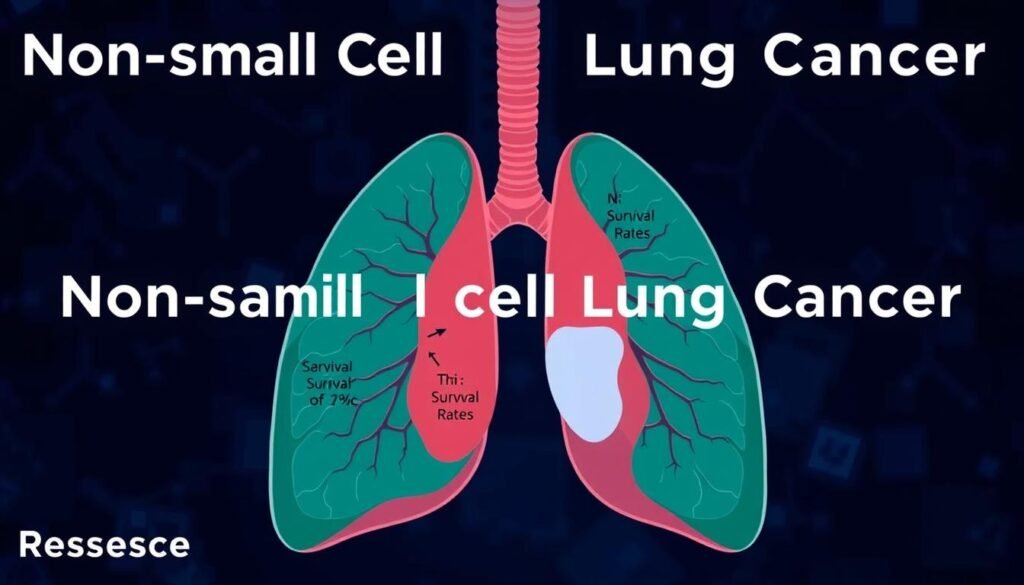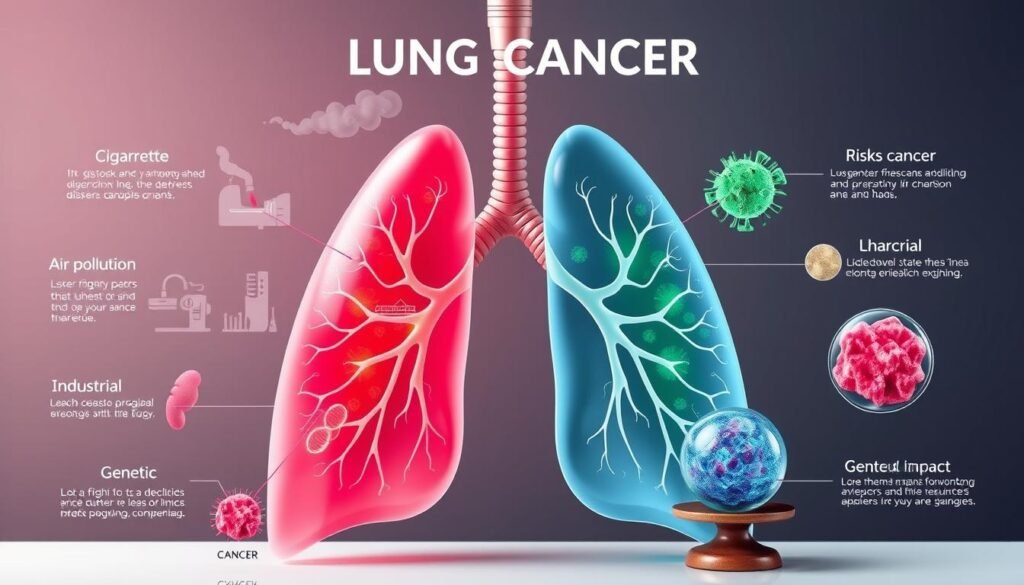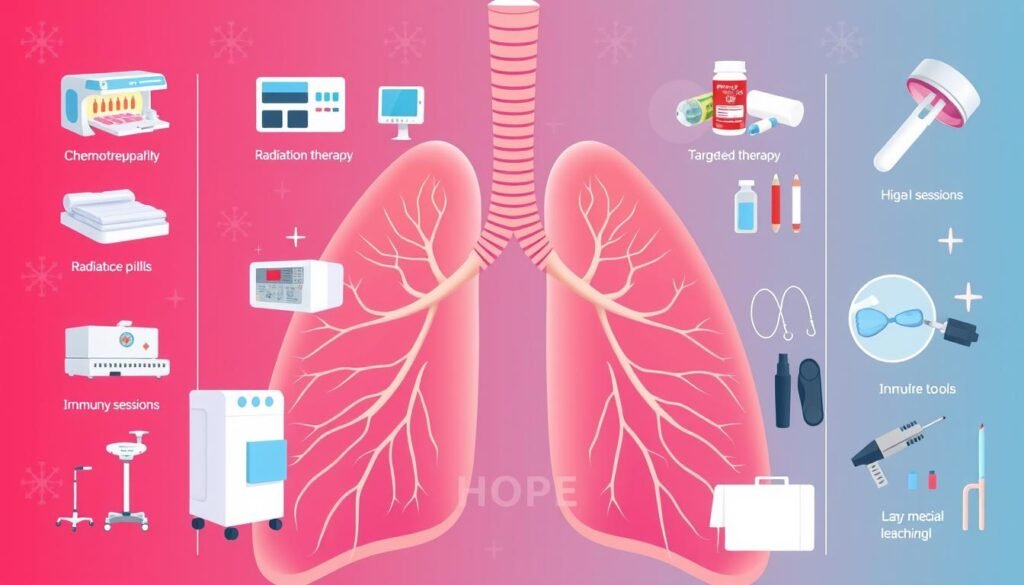Every year, around 236,000 new lung cancer cases pop up in the United States. It’s a top reason people die from cancer. The lung cancer survival rate by stage gives us numbers from past patients. These numbers help in guessing treatment outcomes but don’t predict what will happen to someone.
For example, the 5-year survival for early-stage non-small cell lung cancer is about 65%. But this drops to only 9% when the cancer is found late. Small cell lung cancer survival is even lower, at 3%, for those found at a distant stage. Knowing these statistics is key for better care and hopeful results, despite treatment advances.
Key Takeaways
- The 5-year survival rate for localized non-small cell lung cancer is approximately 65%.
- Lung cancer remains a leading cause of cancer-related deaths in the U.S.
- Smaller cell lung cancer shows a drastically lower survival rate, especially at advanced stages.
- Understanding lung cancer statistics is crucial for making informed treatment decisions.
- Survival rates shed light on the importance of early detection and appropriate staging.
Understanding Lung Cancer Survival Rates
Lung cancer survival rates offer clues about the chance of living with the disease over time. They mainly come from studies that compare lung cancer patients’ survival to people who don’t have cancer. A key figure in these discussions is the 5-year relative survival rate.
What is a 5-Year Relative Survival Rate?
The 5-year relative survival rate shows the percentage of patients living at least five years after finding out they have lung cancer. For instance, if this rate for a certain lung cancer stage is 60%, it means those patients have a 60% chance of living for five years. In comparison, this is like the survival rate of people without cancer. This rate shows how serious the disease can be. It also helps check how well treatments work and guides ongoing research.
How Are Survival Rates Calculated?
Researchers calculate survival rates using big databases, like the SEER database run by the National Cancer Institute. They gather lung cancer data for many years. This helps them spot trends and compare different stages of the disease. But, it’s good to know these figures aren’t perfect. They often depend on old data, which might not show the latest treatment options for patients.
| Lung Cancer Type | Localized 5-Year Survival Rate | Regional 5-Year Survival Rate | Distant 5-Year Survival Rate |
|---|---|---|---|
| Non-Small Cell Lung Cancer (NSCLC) | 65% | 37% | 9% |
| Small Cell Lung Cancer (SCLC) | 30% | 18% | 3% |
Lung Cancer Stages: An Overview
Knowing the lung cancer stages helps us understand how the disease evolves. It shows the treatment choices we have. The stage of cancer is about its size and how far it has spread. This affects the outlook and treatment plan.
Definition of Lung Cancer Stages
Lung cancer falls into three groups:
- Localized: The cancer stays inside the lungs.
- Regional: The cancer has reached nearby lymph nodes.
- Distant: The cancer has spread to other body parts or distant lymph nodes.
Finding the exact lung cancer stage is crucial for choosing the right cancer treatment. Every stage has its own traits and treatment paths. These approaches are aimed at improving how well patients do.
The Importance of Staging in Treatment
The role of staging is key in treating lung cancer. Doctors use staging to pick the best treatment. For example, early-stage cancer might be treated with surgery or specialized therapies. But, more advanced stages often need both chemotherapy and radiation.
Staging early and accurately can bring about quicker treatments, helping more people survive longer. For instance, patients with cancer that hasn’t spread have a 63.7% chance of surviving five years. This chance drops to 21.4% for stage IV cancer. This shows why staging and treatment based on it are so important.
For more on treatment options and their impact on lung cancer, visit this source.
Lung Cancer Survival Rate by Stage: Latest Data
Knowing how different types of lung cancer affect survival rates is important. This knowledge helps patients and their families understand expectations. There is a big difference in outcomes between non-small cell lung cancer (NSCLC) and small cell lung cancer (SCLC).
Survival Rates for Non-Small Cell Lung Cancer (NSCLC)
Most lung cancer cases, about 80-85%, are non-small cell lung cancer. The chance of living five years after diagnosis depends a lot on the cancer stage:
| Stage | 5-Year Relative Survival Rate |
|---|---|
| Localized | 65% |
| Regional | 37% |
| Distant | 9% |
| Combined | 28% |
The figures for NSCLC survival rates consider cases diagnosed from 2012 to 2018. They highlight the difficulty in getting better outcomes, especially in advanced stages.
Survival Rates for Small Cell Lung Cancer (SCLC)
Small cell lung cancer is not as common and grows more quickly than NSCLC. Its five-year survival rates are lower:
| Stage | 5-Year Relative Survival Rate |
|---|---|
| Localized | 30% |
| Regional | 18% |
| Distant | 3% |
| Combined | 7% |
The small cell lung cancer data shows the importance of detecting cancer early. There’s hope that with new treatments, survival rates for all lung cancers will improve.

Factors Affecting Lung Cancer Survival Rates
It’s crucial to understand what affects lung cancer survival rates. This includes knowing the risks, the importance of catching it early, and how overall health can change the outcome. Learning about these can help people make smart choices about their health care.
Overview of Lung Cancer Risk Factors
Many things can raise your risk of lung cancer. These factors are:
- Smoking: This is the main cause, linked to about 85% of cases.
- Environmental pollutants: Being around harmful substances, like asbestos or radon, can increase your risk.
- Genetic predispositions: A history of lung cancer in your family might mean you’re more likely to get it, too.
- Age: Risk goes up as you get older, with most people diagnosed around age 70.
Impact of Early Detection on Survival Rates
Finding lung cancer early is key to better survival chances. Sadly, around 40% of lung cancer is found late, when it’s harder to treat. Going to your doctor for regular check-ups can help catch cancer early, when it’s more manageable.
The American Cancer Society says catching it early can help raise the 5-year survival rate. Right now, it’s about 18.6%. You can learn more here.
Role of Overall Health in Prognosis
Being in good health can change how well you fight lung cancer. People who are healthier often do better with treatment, leading to better survival rates. Age, other health problems, and how fit you are all matter. They affect how well you deal with treatment and recovery. So, staying healthy can really help you through lung cancer treatment.

Recent Advances in Lung Cancer Treatments
In recent years, lung cancer treatments have greatly improved thanks to scientific research. Many new cancer therapies have been developed to help patients. These include targeted therapies and immunotherapies. Personalized medicine has also made a big impact. It offers treatments that are specially designed for a person’s genetic makeup.
Innovative Treatment Options for Patients
Targeted therapies are now a key part of lung cancer treatment. Drugs like Osimertinib and Alectinib focus on certain genetic changes in non-small cell lung cancer. This leads to better outcomes for patients. Immunotherapies, like Pembrolizumab and Nivolumab, offer new options for hard-to-treat cases.
New surgery methods have also improved treatment. Techniques like robotic lobectomy and video-assisted thoracoscopic surgery (VATS) help patients recover faster. They are effective but less invasive. Today, over 90% of early-stage surgeries use these methods.
Clinical Trials and Research Developments
Clinical trials are vital for testing new lung cancer treatments. Studies, including the NIH’s Pragmatica-Lung Study, look at new drug combinations. These trials help develop new therapies. They also show how effective these therapies are compared to standard treatments.
Joining a clinical trial can offer access to the latest treatments. It also helps advance cancer research. This research works to find safer and more effective treatments. For more info on the latest in lung cancer, you can check out recent findings online.

Comparative Survival Statistics Across Stages
The stats for lung cancer at different stages show major differences. This underlines the need for catching it early and treating it right. Knowing these stats helps patients and doctors make smart choices about care.
Statistics for Localized Lung Cancer
The survival rates for early-stage lung cancer look hopeful. Here are the five-year survival rates for non-small cell lung cancer (NSCLC):
| Stage | Survival Rate (%) |
|---|---|
| Stage 1A | 59%-73% |
| Stage 1B | 43%-58% |
| Stage 2A | 36%-46% |
| Stage 2B | 25%-36% |
Survival rates are good if lung cancer is caught early. But as the stage goes up, survival rates go down. This shows why early diagnosis and treatment are key.
Statistics for Advanced Lung Cancer Stages
In contrast, survival rates for late-stage lung cancer drop a lot. People with Stage IV lung cancer have much lower survival rates. This shows how vital it is to deal with lung cancer early.
| Stage | Survival Rate (%) |
|---|---|
| Stage 3A | 19%-24% |
| Stage 3B | 7%-9% |
| Stage 4 | 2%-13% |
Small cell lung cancer (SCLC) stats are especially serious. People with the most advanced disease often have survival rates as low as 1% by stage IV. This info highlights the big gap in survival rates between early and late-stage lung cancer.
For more details on lung cancer and how TNM staging impacts survival rates, check out this page. Understanding these stats can help people take charge of their health care choices.
Lung Cancer Screening Guidelines
Lung cancer screening is key for finding the disease early. Catching it early is linked to better chances of survival. And it’s crucial for people who smoke or are older.
Following the guidelines for lung cancer screening helps a lot. It makes sure the prevention work is as good as it can be.
Importance of Screening for Early Detection
Screening for lung cancer finds it early. This makes treatment more likely to succeed. Every year, a low-dose CT scan is done for those at high risk.
This type of screening finds cancer even before symptoms show up. It helps people have a better chance at beating the disease.
Current Recommendations for High-Risk Individuals
The USPSTF says adults 50 to 80 who smoked a lot should get checked every year. They need to have smoked for 20 pack-years. Screening isn’t for those with health issues that could shorten their life or who can’t have surgery.
People who smoke should get help to quit. This lowers their risk. It’s part of the screening program.
| Criteria | Details |
|---|---|
| Age | 50 to 80 years |
| Smoking History | At least 20 pack-years |
| Health Considerations | Discontinue if health limits life expectancy |
| Recommendations | Smoking cessation for current smokers |
| Screening Method | Annual LDCT scan |
Putting these guidelines to use is crucial. It helps catch lung cancer early in people at high risk. Making choices together leads to better health outcomes.
Improving Lung Cancer Outcomes
The battle against lung cancer is moving fast, with new hope on the rise. Researchers are pushing the boundaries with studies and new treatments. They focus on using gene therapy and personalized care. These new cancer treatments aim to change the lung cancer fight, focusing on specific genes and personal patient needs. These advances could greatly help in fighting lung cancer.
Upcoming Treatment Breakthroughs
Learning more about genetic changes like EGFR, KRAS, and ALK leads to better treatments. For example, people with EGFR mutations often live longer. This shows why genetic tests are key in planning care. Researchers are working on treatments that target these genes. This could make cancer care much more effective.
How Lifestyle Changes Can Impact Survival
Making personal life choices can also affect lung cancer results. Adding lifestyle changes for cancer survival can make treatments work better. Not smoking is one big way to improve health. Eating lots of fruits and veggies, and exercising regularly, also help. There’s more proof that these choices help. They let patients help in their own care, showing how taking charge can make a real difference in fighting lung cancer.
Conclusion
Knowing about lung cancer survival rates is very important. Catching the disease early, especially in Stage 1, can result in a survival rate of 70-90%. Sadly, only 16% are found at this stage. This shows why we must push for better lung cancer awareness and early testing. It can save lives.
Survival rates drop as cancer advances. For those reaching Stage 4, the rate falls to 3-8%. Age, whether someone has smoked, and overall health are big factors. It’s crucial for patients to talk clearly with their doctors. This way, they can look into every treatment possibility to improve their survival chances.
Giving patients details on survival rates and risk factors encourages them to manage their health better. Talking with health experts and finding support resources helps a lot. By promoting lung cancer awareness and early testing, patients can greatly improve their battle with this illness.